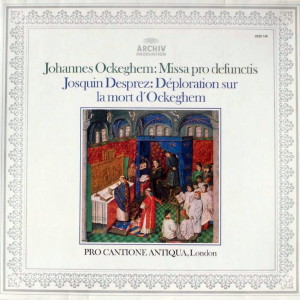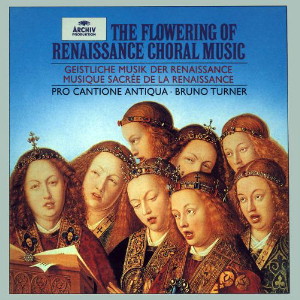 |
|
1 LP
- 2533 145 - (p) 1973
|
 |
| 7 CD's
- 445 667-2 - (c) 1994 |
|
| Geistliche Musik des 15. und
16. Jahrhunderts (Franko-Flämische
Schule) |
|
|
|
|
|
|
|
| Johannes Ockeghem
(ca.1410-1492) |
|
|
|
|
| Missa pro
defunctis |
Codex C. VIII.
234, Coll. Chigi, Bibl.
Vaticana, Roma. Transcription:
Bruno Turner
|
|
35'
30" |
|
- Introitus
|
|
6' 08" |
|
A1 |
- Kyrie
|
|
6' 24" |
|
A2 |
- Graduale
|
|
6' 46" |
|
A3 |
- Tractus
|
|
8' 04" |
|
B1 |
- Offertorium
|
|
8' 08" |
|
B2 |
|
|
|
|
|
| Josquin Desprez
(ca.1440-1521) |
|
|
|
|
| Déploration sur
la morte d'Ockeghem |
Gesamtausgabe:
"Werken von Josquin des Pres",
Ed. Albert Smijers, Amsterdam
(bis 1942 auch Leipzig), 1921 ff.:
Weltliche Werke I, Nr.
22
|
|
5' 32" |
B3 |
|
|
|
|
| PRO CANTIONE ANTIQUA, London |
HAMBURGER
BLÄSERKREIS FÜR ALTE MUSIK |
| - James Bowman,
Paul Esswood, Kevin Smith, Counter-Tenor |
- Detlef Hagge, Zink
(Cornetto muto) |
| - John Elwes,
James Griffett, James Lewington, Tenor |
- Fritz Brodersen,
Alt-Posaune (Trombone alto) |
| - Mark Brown,
Brian Etheridge, David Thomas, Bass |
- Hubert Gumz, Tenor-Posaune
(Trombone ténor) |
|
- Hans von Busch
(Tenor-Pommer (Bombarde ténor) |
|
|
|
Bruno Turner,
Leitung |
|
|
|
|
Luogo
e data di registrazione |
|
Friedrich-Ebert-Halle,
Hamburg-Harburg (Germania) - 8/10 febbraio
1973 |
|
|
Registrazione:
live / studio |
|
studio |
|
|
Production |
|
Dr. Andreas
Holschneider |
|
|
Recording
Supervision
|
|
Franz-Christian
Wulff |
|
|
Recording
Engineer |
|
Wolfgang
Mitlehner |
|
|
Prima
Edizione LP |
|
ARCHIV - 2533
145 - (1 LP - durata 41' 24") - (p) 1973 -
Analogico |
|
|
Prima
Edizione CD |
|
ARCHIV - 445
667-2 - (7 CD's - durata 72' 13", 65' 04",
78' 03", 75' 33", 53' 56", 77' 30" &
66' 38") - (c) 1994 - ADD
CD3 1-6
|
|
|
Cover |
|
Philipp der
Gute wohnt einer Messe in seiner Kapelle
bei (Miniatur gegen 1460, Copyright
Bibliothèque Royale Albert 1er, Bruxelles) |
|
|
|
|
The Missa
pro defunctis (Requiem Mass)
composed by Johannes Ockeghem in the
second half of the fifteenth century
stands as a monument to the dying Middle
Ages, a masterpiece of its era and
certainly one of the most extraordinary
musical works of the time. It is
extraordinary because it is the earliest
setting of the Requiem Mass to have
survived to our day (Dufay’s is lost);
it is extraordinary in its variety of
mood, musical texture, style and
technique, and it is extraordinary in
its power to capture the imagination and
to move the listener after five
centuries of obscurity. The poet
Guillaume Cretin, called it “la
messe ... exquise et tres parfaicte”.
The nineteenth century musicologist
Ambros hoped for the discovery of the
music and now, along with many other
works by Ockeghem, we have it in a
beautiful Flemish manuscript written,
just a few years after the composer’s
death, by the scribe Martin Bourgeois of
Ghent. This fine choirbooik was used in
Spain in the early sixteenth century and
is now in the Chigi Collection in the
Vatican Library, Rome. It is the only
source of Ockeghem’s Requiem that has
been preserved.
In his own time, Ockeghem’s music was
greatly admired, and, as a man, he was
honoured and indeed loved by his
colleagues and contemporaries. Whilst he
was alive he was complimented in music
by the composer Antoine de Busnois (the
motet “In hydraulis”) and by
Loyset Compère (“Omnium bonorum
plena”). The theorist and
writer Johannes Tinctoris praised
Ockeghem as “optimus compositor ac
dulcedinis accuratus exquisitor”.
When Ockeghem died in 1495, Cretin wrote
a lament in which he called on the
living composers (including Josquin and
Brumel) to weep for their “maistre
et bon père”. Erasmus of Rotterdam
did likewise in his elegy “Ergo ne
conticuit”, and made a gentle pun
when he referred to the “aurea vox
Okegi” (the golden voice of
Ockeghem), complimenting the dead
master’s wealth (as Treasurer of the
Abbey of St. Martin at Tours), his great
bass voice, and of course, the beauty of
his music.
In 1477, Tinctoris praised Ockeghem as
one of the greatest of the “moderns”,
and thought that in his time music had
virtually been recreated as a new art.
Yet, within a few years, the humanistic
revolution of the Renaissance swept away
the late mediaeval style. The soaring
assymetric melodies, the almost wordless
linear counterpoint of Ockeghem was
replaced by the mature style of Josquin,
in which verbal clarity and clear-cut
design served a new expressive purpose.
Glimpses of a Renaissance dawn are to be
found in the music of Dufay and of
Ockeghem, but Ockeghem belongs to the
twilight of the Gothic Era, spiritually
and technically. Josquin, for us, is
Renaissance Man; Ockeghem belongs to
that “Waning of the Middle Ages” of
which the historian Huizinga wrote so
eloquently. The Ockeghem style was
already somewhat out of fashion by the
end of his life, and by 1547, two
generations later, Glareanus, the great
admirer of Josquin, could only refer to
Ockeghem as a shadowy, almost mythical
figure from the past.
In our own century, musicologists and
practical musicians have been
increasingly attracted to this remote
Flemish master. Now that his music is
becoming known in print and in
performances, the true nature of
Ockeghem’s genius is becoming apparent.
Far from being the writer of a few
extraordinary puzzle-canons, the
supposed perpetrator of a “twittering
for 36 voices”, Ockeghem emerges as the
master of extremely free and expansive
melody, assymetric in contour,
unpredictable and imaginative in design,
full of intricate detail, almost never
repetitive and making very little use of
melodic imitation or sequence. His
polyphony is utterly linear and his
harmony, beautiful as it is at times, is
almost always the result of the
confluence of his very independent
melodic lines. The music seems to grow
organically like the tendrils of a
plant. They are part of one real
organism but they take their own shape
and direction. Perhaps in Ockeghem’s
style we have the ideal linear
polyphony.
Johannes Ockeghem (Jean d’Okeghem,
Okegus, Ockenheim, Hoquegan, Obghuen -
his name is found in thirty-nine
different spellings) was born in East
Flanders, probably at Termonde, possibly
as early as 1420 and not later than
1430. Young man or boy, he was a singer
at Antwerp Cathedral for a year in
1443-44. Two years later he joined the
chapel singers of Duke Charles of
Bourbon at Moulins. It is possible that
Ockeghem visited Cambrai in about 1450
and may have met Dufay. He is also
reported as having been a pupil of
Binchois, and, when that composer died
in 1460, Ockeghem wrote a touching
lament “Mort, tu as navré”.
In 1453 Ockeghem joined the Royal Chapel
of Charles VII of France, who, despite
his defeat of the English, continued to
hold his court at Bourges or at Tours
rather than in Paris. Ockeghem must have
been favoured with intelligence and
personality as well as ability as a
musician, for soon he was “premier
chapelain”, and then in
1459 he was given the remunerative
appointment of Treasurer of the Abbey of
St. Martin at Tours. This was a great
and Royal honour, for the Kings of
France were the Abbots of St. Martin. In
1465 Ockeghem had the title of “Maistre
de la chapelle de chant du roy”.
In 1470 he went to Spain, and he paid
certainly one visit to his native
Flanders in 1484. He spent his life as
composer and chapel master to three
Kings of France, Charles VII (died
1461), Louis XI (died 1483) and Louis
XII in whose service he died at Tours in
1495.
His surviving Works consist of eleven
complete masses, three masses consisting
of two or three movements, nine or ten
motets and some twenty chansons. He
wrote some masses in a free style,
others are based on liturgical or
chanson “tenors” (cantus firmus);
he wrote his Missa Cuiusvis toni
without clefs to test his singers’
knowledge of the four authentic church
modes. His Missa Prolationum is
a tour de force, a cycle of
metrical double canons. He contrived to
spell out by numerology the name Egidius
de Binche in the proportions of
his scheme of the cantus firmus
in his Mass on Gilles Binchois’ chanson
“De plus en plus”. By the same
means he hid the words Ave Maria,
gratia plena in his Mass on the
plainsong Ecce ancilla Domini,
which celebrates the Annunciation of the
Archangel Gabriel to the Virgin Mary.
Yet, to the listener, Ockeghem’s music
never suffers from this mediaeval
obsession with numbers, symbols and
canonic devices.
Above all, Ockeghem left for posterity
his austere and beautiful Requiem Mass.
It is steeped in the ancient plainsong
of the Mass for the Dead. In each
movement the topmost voice paraphrases
and elaborates the hallowed chant.
Fragments of the old melodies serve as
springboards for Ockeghem’s lyrical
imagination. Constantly changing his
textures, he uses every combination of
the basic four parts in duos, trios and
full four-voice tutti sections. The Kyrie
is remarkable in its full ninefold
scheme.
In the Graduale and Tractus
Ockeghem uses texts that are unfamiliar
now as part of the Requiem Mass, but in
his day the standardisation of the
Council of Trent (in 1570) had not come.
In the Graduale, the verse Virga
tua takes the form of an immense
duet almost to the end, but Ockeghem
introduces, with deliberate expressive
intent, all the voices with splendid and
solemn calm at the words “consolata
sunt”. In the Tractus
there is another moment of deliberate
expression when the tenor, below a duo
for high voices, comes in with short
“weeping” phrases in the verse “Fuerunt
michi lacrimae meae panis die ac
nocte”.
In the Offertorium there is a
shattering moment of vivid imagination
at the words “de manu inferni et de
profundo lacu”. This is an
outburst, highly decorated and
syncopated, demanding virtuoso singing.
It is as startling and as vivid as
anything in the visions of hell in the
paintings of Hieronymus Bosch.
We do not know when or for what occasion
Ockeghem wrote his Requiem, but it is
more than likely that he wrote it with
his royal master, Louis XI, in mind.
Louis might well have commissioned it,
for he was obsessed with death and
gathered round him not only relics by
the cartload, but established at his
court all manner of “holy men”, mystics
and saints including the filthy hermit
of Calabria, St. Francis of Paula.
Surely, such a King would have seen to
it that his choirmaster was ready for
the day. It may well be that Ockeghem’s
masterpiece was sung when Louis XI died
in 1483.
When Ockeghem, himself, died in 1495 he
was lamented in music by Josquin Desprez
who set a “déploration” by the
poet Molinet. In the first section,
Josquin writes in a style that is a
deliberate compliment to Ockeghem’s own
continuous and seamless musical texture,
and in it Josquin has embedded the
plainsong melody and words of the Introitus
“Requiem aetemam”, but although it
is notated in the normal way, Josquin
directs that this cantus firmus
shall be sung “ung demiton plus bas”,
thus turning the ancient chant into the
wailing Phrygian Mode. In the concluding
short section, Josquin set, in his own
expressive style, the words which
implore the living composers, Brumel,
Pierre de la Rue, Compère and Josquin
himself to weep for the “bon père”.
A solemn “Requiescat in pace”
ends one of the most moving laments ever
composed.
Bruno
Turner
|
|
|

